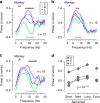Neural oscillations in the primate caudate nucleus correlate with different preparatory states for temporal production
- PMID: 30886911
- PMCID: PMC6418172
- DOI: 10.1038/s42003-019-0345-2
Neural oscillations in the primate caudate nucleus correlate with different preparatory states for temporal production
Abstract
When measuring time, neuronal activity in the cortico-basal ganglia pathways has been shown to be temporally scaled according to the interval, suggesting that signal transmission within the pathways is flexibly controlled. Here we show that, in the caudate nuclei of monkeys performing a time production task with three different intervals, the magnitude of visually-evoked potentials at the beginning of an interval differed depending on the conditions. Prior to this response, the power of low frequency components (6-20 Hz) significantly changed, showing inverse correlation with the visual response gain. Although these components later exhibited time-dependent modification during self-timed period, the changes in spectral power for interval conditions qualitatively and quantitatively differed from those associated with the reward amount. These results suggest that alteration of network state in the cortico-basal ganglia pathways indexed by the low frequency oscillations may be crucial for the regulation of signal transmission and subsequent timing behavior.
Conflict of interest statement
The authors declare no competing interests.
Figures






Similar articles
-
Temporal Information Processing in the Cerebellum and Basal Ganglia.Adv Exp Med Biol. 2024;1455:95-116. doi: 10.1007/978-3-031-60183-5_6. Adv Exp Med Biol. 2024. PMID: 38918348 Review.
-
Different contributions of preparatory activity in the basal ganglia and cerebellum for self-timing.Elife. 2018 Jul 2;7:e35676. doi: 10.7554/eLife.35676. Elife. 2018. PMID: 29963985 Free PMC article.
-
A neural correlate of response bias in monkey caudate nucleus.Nature. 2002 Jul 25;418(6896):413-7. doi: 10.1038/nature00892. Nature. 2002. PMID: 12140557
-
Primate basal ganglia activity in a precued reaching task: preparation for movement.Exp Brain Res. 1993;95(1):51-64. doi: 10.1007/BF00229653. Exp Brain Res. 1993. PMID: 8405253
-
Functional aspects of, and the role of transmitter in, the basal ganglia.Confin Neurol. 1974;36(4-6):282-91. doi: 10.1159/000102802. Confin Neurol. 1974. PMID: 4156664 Review. No abstract available.
Cited by
-
Temporal Information Processing in the Cerebellum and Basal Ganglia.Adv Exp Med Biol. 2024;1455:95-116. doi: 10.1007/978-3-031-60183-5_6. Adv Exp Med Biol. 2024. PMID: 38918348 Review.
-
Entrained neuronal activity to periodic visual stimuli in the primate striatum compared with the cerebellum.Elife. 2019 Sep 6;8:e48702. doi: 10.7554/eLife.48702. Elife. 2019. PMID: 31490120 Free PMC article.
-
Is the scalar property of interval timing preserved after hippocampus lesions?J Theor Biol. 2021 May 7;516:110605. doi: 10.1016/j.jtbi.2021.110605. Epub 2021 Jan 26. J Theor Biol. 2021. PMID: 33508325 Free PMC article.
-
Single caudate neurons encode temporally discounted value for formulating motivation for action.Elife. 2021 Jul 30;10:e61248. doi: 10.7554/eLife.61248. Elife. 2021. PMID: 34328413 Free PMC article.
-
Effects of Optogenetic Suppression of Cortical Input on Primate Thalamic Neuronal Activity during Goal-Directed Behavior.eNeuro. 2021 Mar 23;8(2):ENEURO.0511-20.2021. doi: 10.1523/ENEURO.0511-20.2021. Print 2021 Mar-Apr. eNeuro. 2021. PMID: 33658308 Free PMC article.
References
Publication types
MeSH terms
LinkOut - more resources
Full Text Sources

